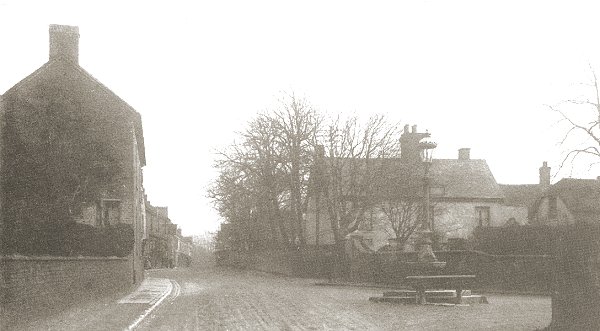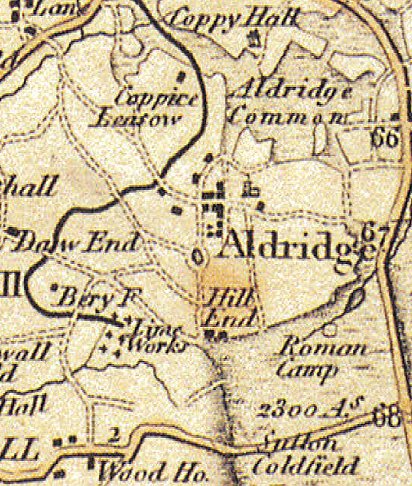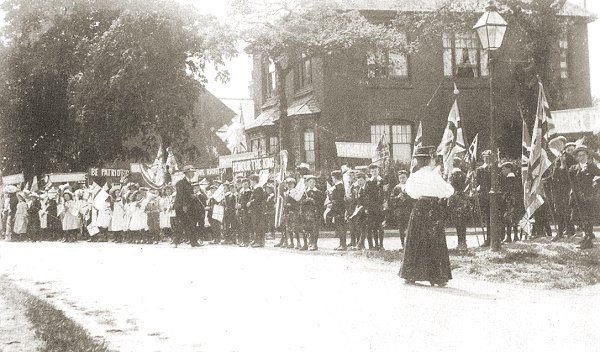|
 |
|
In the early years of the seventeenth
century, Robert Stamford of Perry Hall and Edward Leigh of
Rushall Hall became Justices of the Peace, and heard many
cases ranging from thefts, land disputes, wage settlements,
arranging the upkeep of illegitimate children, and the
punishment of their parents. In one case, the father, John
Sabin, was ordered to sit in the stocks at Walsall for three
hours on a Sunday afternoon. The mother, Alice Godwin, was
ordered to do the same after her churching ceremony. In
another case, the father, Robert Hopkis was punished by
being publically whipped in Wolverhampton market place,
followed by making a payment of eight pence a week to the
mother for four years.
In the Civil War, Edward Stamford, lord
of the manor of Great Barr and Aldridge fought on the king’s
side, and was captured by the Roundheads in 1644 and held at
Eccleshall Castle. His estates were confiscated, and his
wife pleaded that she was destitute to the Staffordshire
County Committee, who agreed to let her remain at Perry
Hall, and receive one fifth of the income from the estate,
providing that she paid the weekly contribution for the
maintenance of the Parliamentarian troops in the county,
which everyone was expected to pay. The estate was
administered on behalf of the committee by Mr. Erpe of
Stonnall, and Thomas Jorden of Perry Barr.
|

Aldridge High Street around 1911. From an old
postcard.
|
Difficult Times
In the seventeenth century the use of
common land was strictly controlled by the manorial court.
Anyone caught disobeying the many rules could expect a hefty
fine. In 1685 rams were not allowed loose on the common
after the 15th September, fern could not be cut or burnt
before the 24th June, and peat or turf could not be cut
before the 8th May. Any peat or turf that was cut had to be
for the use of people living within the manor. Corn fields
had to be properly fenced. A fine was imposed for any gaps.
The cutting of gorse growing in ditches or on banks was
forbidden. This was used to form the base of haystacks
because mice were unable to crawl through it, into the
stack.
The nature of the common changed due to
the burning of fern, which encouraged the growth of grass
and improved the land for the grazing of sheep. This
practice was unpopular with the hunting fraternity because
it reduced the area on which they could hunt and shoot. In
1769 Aris’s Birmingham Gazette carried an advert offering a
reward of no less than five guineas for information leading
to the conviction of anyone starting a fire on the common.
In 1795 the local wealthy landowners
got together and introduced a Private Bill to parliament for
the enclosure of the common land, which they intended to use
for sheep farming. The Bill was quickly passed, so quickly
that the poor commoners had no time to object, and no
provision was made for them. In reality there was little
they could do because they could not afford the legal fees
that would be necessary to oppose the bill.
Those receiving land had to completely
enclose it with ditches and hedges before 5th April, 1800. If
the work had not been completed by then, a neighbour could
complete the enclosure, and claim the cost of the work. In
Aldridge itself, 344 acres were enclosed between seventy
eight claimants, twenty seven of whom had less than one
acre. The Rector, who received five and a half acres was
excused the cost of fencing his land.
They were desperate times for the poor.
Houses owned by Aldridge parish had to be sold to make ends
meet. Many poor people ended-up in Shenstone Workhouse.
The wealthier families who benefitted
from the enclosures did little to help the poor. Mrs Foley,
and Mrs Whitby received 632 acres, Sir Joseph Scott received
192 acres, and Ann Scott received 114 acres. In 1795, the
year of the enclosure act, the levy book records that Mrs
Scott paid £11 to the poor rates, whereas Sir Joseph Scott,
Mrs Whitby, and Mrs Foley paid nothing, presumably because
their land and property was leased, so their tenants had to
pay instead.
Some people could not afford to pay the
poor rates. In September 1818 six Aldridge men appeared
before the Justices of the Peace at Wednesbury for none
payment of the rates. The sums owed ranged from 5 shillings,
owed by Sam Parkes, to £4.12s.9d. owed by William Simkins.
Anyone wishing to move into the parish was only allowed to
do so if they could pay their way, and would not become a
liability. Members of the armed forces and their families
could claim expenses from parishes they travelled through,
during a journey. In December 1824 eleven soldier’s wives
and their eighty one children claimed relief to enable them
to reach Tamworth, which cost the parish £2.1s.4d. Children
of servicemen could also claim their parent’s relief.
There were many illegitimate children
in the country who had to be looked after by their local
parish. This led to a large financial burden on some
parishes. In Aldridge, anyone unmarried and pregnant would
be taken to a local justice by the church wardens and
questioned in an attempt to discover the name of the father.
Everything would then be done to force the couple to marry,
or to see that the father paid all of the expenses. The
parish had to arrange for all such children to be looked
after until they reached the age of seven, when they were
sent as parish apprentices. They were sent to a family and
had to serve their master in return for accommodation, food,
clothing, and instruction in their master’s craft. Females
remained as apprentices until they reached the age of 21, or
got married. Men remained as apprentices until they reached the age
of 24. In 1777 this age was reduced to 21.
|

The Fountain in High Street. From an old
postcard.
|
The Hoo, the Scott Families, and Great
Barr Hall
In the early eighteenth century John
Hoo was Lord of the Manor of Great Barr, and also Lord of
the Manor of Wednesbury. Little is known about him, but he
appears to have been a caring man who took great interest in
the affairs of the parish. He died in 1740 at the old manor
house in Wednesbury, and was succeeded by his son John, who died
nine years later. He was followed by his brother Thomas who
lived at Old Hall Farm, Old Hall Lane, Great Barr, close to
Barr Beacon School. The half-timbered building still exists.
It was the local manor house, owned by the Scott family from
the middle of the sixteenth century, until the eighteenth
century when Joseph Scott rebuilt the ‘Netherhouse’, turning
it into Great Barr Hall.
Thomas, a confirmed bachelor, was
devoted to fox hunting. It was said that he once intended to
marry, but his bride to be took a dislike to his hounds,
which were kennelled at Old Hall Farm. As a result, the
marriage never happened, and Thomas stated that ‘No woman is
worth fifty hounds!’ He lived in some style on his estate,
barred women from there, other than his neighbour, Mrs
Galton, who he described as ‘The only reasonable woman in
the world’. He also allowed her daughter Ann to visit him.
She had been allowed to roam over his estate since she was a
child.
In 1772 he became the High Sheriff of
Staffordshire, and like his father was involved in parish
affairs. He held the unpaid office of Surveyor of Roads, and
ran many of the charities that were associated with the
church to help the local poor. He owned much of Great Barr,
many properties in Wednesbury, and a profitable coalmine at
Bradley. He died in 1791 and is buried at St. Mary’s Church
in Aldridge.
His estate was handed-down to two
distant female relatives, both having an equal share. They
were his second cousin, Mary Whitby, and her cousin
Elizabeth Maria Foley Hodgetts, who became joint Ladies of
the Manor until the end of the eighteenth century. In 1777
Sir Joseph Scott married Margaret Whitby, the only daughter
of Mary Whitby, and her late husband Edward. He received a
dowry of £2,000 which he spent on renovating his home, the ‘Netherhouse’,
later known as Great Barr Hall.
The Scott family came to the area in
the middle of the seventeenth century when Richard Scott
acquired the "Netherhouse" in Great Barr. The 1666 Hearth
Tax Return confirms that this was one of the larger
buildings in the area, as it had five hearths.
|
|

Part of Yates' 1798 map of
Staffordshire. |
Sir Joseph Scott spent money on his
estate with reckless abandon, resulting in many debts which
he couldn’t pay. In order to raise money he was forced to
let the hall and parkland, and leased the property to Samuel
Galton, the wealthy banker, gun maker, and member of the
Lunar Society, who lived at Duddeston. The Galton family
moved into the hall in the mid 1780s, and with the money
received, Sir Joseph went off on the Grand Tour of Europe.
During Galton's tenancy, the Hall became one of the meeting
places for the Lunar Society. Sir Joseph’s financial problems were
resolved in 1795, when, on the death of his mother-in-law
Mary Whitby, he acquired her fortune and estates. He became
captain of the Walsall Volunteer Association, founded in 1798
during the war with France. When the association was
disbanded in 1802, he received for his efforts, a silver cup
worth 50 guineas. A large sum of money at the time. In 1799
he served as High Sheriff of Staffordshire, and was elected
Member of Parliament for Worcester between 1802 and 1806. On
30th April 1806 he was created 1st Baronet Scott of Great
Barr. |
|
Sir Joseph Scott and the Charity
Commissioners
Sir Joseph Scott was heavily criticised
by the Charity Commissioners in their report of 1825. He had
exchanged the land he received when the common was enclosed,
for land that had been left to the parish, to be used for
the upkeep of the parish clerk. Because this land contained
timber worth £112, the Commissioners asked for compensation.
The land had also suffered due to the negligence of Sir
Joseph’s tenants.
He declined to pay, and pointed out that
he had spent £1,750 on the chapel, which didn’t go down very
well with the Commissioners. They stated that the money had
been spent on none-essential work including a spire and six
bells, an organ, stained glass windows, battlements, a
porch, alter cloths, and cushions etc. The essential work
consisting of building maintenance and new pews could only
be carried out by borrowing £523 from John Fellowes, a
chapel warden. Some of the clerk’s land had to leased to
pay-off £220 of the loan.
Sir John was also criticised for the
none-payment of a dole on Shustock Meadows which he owned.
He also took £30 rent from the schoolmistress for her house,
even though it was not clear if he actually owned it.
Sir Joseph and Margaret had three
children, Edward Dolman, William, and Mary. On Sir Joseph’s
death in 1828 he was succeeded by his eldest son, Edward
Dolman Scott, who became 2nd Baronet Scott of Great Barr.
The Scott family continued to improve Great Barr Hall.
Between 1800 and 1830 extensions were built, and a clock
tower was added between 1830 and 1848. In 1863 a chapel
designed by Sir Gilbert Scott was added to the building, and
actually used as a billiards and trophy room. Further
extensions were added in the 1890s by the last family
occupant, Lady Bateman-Scott who died in 1909.
After the death of Lady Bateman-Scott,
the hall was sold for £28,000 at auction, in October 1911,
to West Bromwich Poor Law Guardians for use as a hospital.
Walsall Poor Law Guardians soon joined the project in an
attempt to alleviate overcrowding in existing poor law
establishments.
April 1914 saw the completion of the
first new building on the site, the Derby Home, a wooden
structure designed to house TB patients. It later became an
annexe to the children’s home, and was finally used for
staff accommodation. A building for people with severe
mental problems, known as Great Barr Park Colony, opened at
the end of the First World War, and Sanders Home, offering
accommodation for children under five years of age opened in
April 1926.
By 1938 more buildings had been added
for the accommodation of boys and men which became known as
the ‘Male Side’. The older building, now purely for the
accommodation of women, became known as the ‘Female Side’.
In 1948 at the start of the National
Health Service, the whole site became known as St Margaret's
Hospital. It formally closed in March 1997, but a small
number of high-dependency patients remained there until
2004. Sadly the hall has since been derelict, and is falling
into a sad state of disrepair. Its future is now uncertain.
|

Aldridge schoolchildren celebrating Empire Day
in 1906. From an old postcard.
 |
|
 |
|
 |
Return to
The Middle Ages |
|
Return to
the contents |
|
Proceed to
The 19th Century |
|